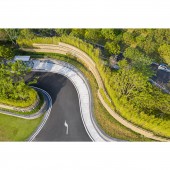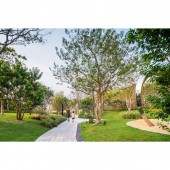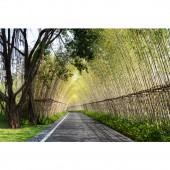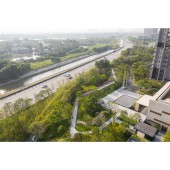Poly Moonlight Bay Landscape And Garden by IAPA Pty. Ltd |
Home > Winners > #87334 |
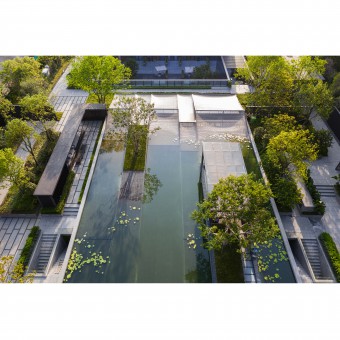 |
|
||||
| DESIGN DETAILS | |||||
| DESIGN NAME: Poly Moonlight Bay PRIMARY FUNCTION: Landscape And Garden INSPIRATION: The design area is the edge of a residential block and includes residential apartments and a selling center, which will be re-used into a community center after selling of the apartments. The site is surrounded by different natural features including river and park. Moreover, Landscape is designed a way to connect the block to the main road passing alongside it. Considering the site’s natural characteristics, design language is based on organic behavior in response to its neighboring park and the river. It integrates the architecture of the block with its natural context and ties the residential site to the city in a different way by blending it with nature. The design is inspired by the relationship between figure and garden in a traditional Chinese garden but using design techniques to re-interpret it into more contemporary design language. UNIQUE PROPERTIES / PROJECT DESCRIPTION: Bamboo forest, flower forest, foggy forest, dry creek, ripple, and many different other features are just some of the landscaping design elements. They have made the visit to the site like experiencing a beautiful tour in nature but at the heart of a city. The landscape creates an interesting journey for the user who enters the site. It takes the user to the different depths of the space within an internal organization system and builds a walkable and discoverable project beyond its formal agencies. The program is defined in a flexible way to be able to adapt itself with different needs of its inhabitants. The inhabitants who are constantly live in residential apartments or temporarily comes to the site for using the future community center. What Poly Moonlight Bay landscape design is offering to its user is a different lifestyle of being in a close relationship with nature rather than being isolated by a typical urban life. OPERATION / FLOW / INTERACTION: The project provides people a continuous experience of walking in nature. It is a threshold, a threshold that mediates between urban life and the natural environment. While different landscaping elements making various spatial features. Through a set of mountainous elements, the community center building is connected to the courtyard. Designed in a way to create a feeling that landscape changes between light and water; resembling the waterfront space in Lingnan Garden. The project creates a pleasant space of meditation using a modern design language, as well as creating an experience of the seasonal changes in light and plants. Undulating surfaces allows pedestrians to capture different views while building multiple kinds of visual connectivity within the garden and brings a dynamic spatial experience for the user. PROJECT DURATION AND LOCATION: the Project is designed and built during 2018-19 the project is located in Foshan, Guangdong |
PRODUCTION / REALIZATION TECHNOLOGY: Wood, perforated metal sheet, stone, concrete SPECIFICATIONS / TECHNICAL PROPERTIES: The area of the project is 23138 square meters TAGS: Nature, Chinese garden typologies, figure-ground relationship, architecture and nature relationship, introverted architecture, extroverted architecture RESEARCH ABSTRACT: The research phase is formed around a reading of the traditional Chinese garden. With a concentration on the relationship between architecture and nature. To use the idea of multidimensionality in modern design language but preserving the main spatial characteristics of a Chinese garden. CHALLENGE: Urban development and urban life in China have changed the Living condition and lifestyles of the people. The project tries to build a constant friendship between its inhabitants and nature by the medium of landscape design. Maximizing the diversity and flexibility of a housing garden has been a creative challenge for the project and design is taking advantage of different techniques to achieve that. ADDED DATE: 2019-06-14 08:17:43 TEAM MEMBERS (8) : Landscape designer: Chen Yonglun, Landscape designer: Han Qingchou, Landscape designer: Liu Hengyi, Landscape designer: Zhang Xiqian, Landscape designer: Zhu Wenting, Landscape designer: Zhong Quan, Design director: Yu Ding and Design Chief: Paul Bo Peng IMAGE CREDITS: IAPA |
||||
| Visit the following page to learn more: https://mooool.com/en/poly-moonlight-bay |
|||||
| AWARD DETAILS | |
 |
Poly Moonlight Bay Landscape and Garden by Iapa Pty. Ltd is Winner in Landscape Planning and Garden Design Category, 2019 - 2020.· Read the interview with designer IAPA Pty. Ltd for design Poly Moonlight Bay here.· Press Members: Login or Register to request an exclusive interview with IAPA Pty. Ltd. · Click here to register inorder to view the profile and other works by IAPA Pty. Ltd. |
| SOCIAL |
| + Add to Likes / Favorites | Send to My Email | Comment | Testimonials | View Press-Release | Press Kit |
Did you like Iapa Pty. Ltd's Landscape Design?
You will most likely enjoy other award winning landscape design as well.
Click here to view more Award Winning Landscape Design.


